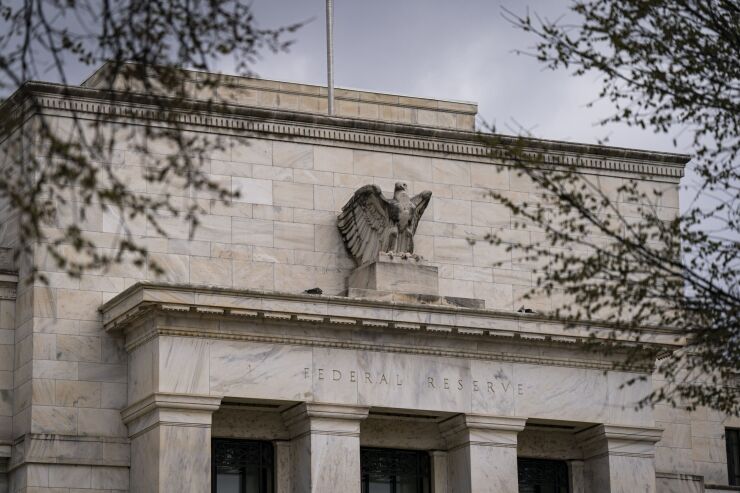
Not for the first time, the Federal Reserve has intervened with a liquidity facility aimed at cushioning banks and other depository institutions buffeted by a crisis.
On Sunday, the central bank unveiled the Bank Term Funding Program, which offers banks, credit unions and other eligible institutions loans to shore up their liquidity. Under the program, the Federal Reserve is pledging to make loans from 90 days to 12 months in duration. There are no minimum or maximum borrowing amounts.
The effort aims to "bolster the capacity of the banking system to safeguard deposits and ensure the ongoing provision of money and credit to the economy," the Fed said in a press release.
Operationally, the program is relatively simple: In exchange for funding, banks and other prospective borrowers can pledge U.S. Treasuries, agency debt and mortgage-backed securities, and other qualifying assets as collateral. Assets will be valued at par, rather than the lower market values that many of them currently have as a result of rising interest rates.
To obtain funds, prospective borrowers must submit a request using a standard email template that is available on the
The program's rollout came four days after the now-shuttered Silicon Valley Bank sent shock waves through the financial system, with a plan to sell $21 billion of available-for-sale securities at a steep discount to compensate for deposit outflows.
Silicon Valley had expected to recoup losses from the securities sale by raising $2.25 billion in fresh capital, but that plan quickly collapsed, triggering a crisis of confidence among investors and depositors. A run on the bank ensued, and
Then on Sunday, when regulators shut down the $110 billion-asset Signature Bank, concerns about the banking system's systemic health quickly mushroomed. New York-based Signature had built a reputation as a crypto-friendly bank, which worked to its benefit while the cryptocurrency market waxed, but morphed into a serious liability when it began to wane
In the immediate aftermath of the Silicon Valley Bank failure, regulators and the Treasury Department appeared to take a tough line. The Federal Deposit Insurance Corp. stated Friday that it would cover depositors up to $250,000, the ceiling for deposit insurance, and Treasury Secretary Janet Yellen insisted early Sunday there would be no bailout for Silicon Valley.
But before the weekend was over, government officials
Clearly, government officials are seeking to protect the rest of the financial services industry from the liquidity issues that sank those two banks. The question now is: Did they go far enough?
On Monday, many small banks were still turning to the Federal Home Loan Bank System for liquidity largely because the Bank Term Funding Program just opened, according to Peter Freilinger, founding partner at Paladin Advisors Group, a wealth management and financial advisory firm in Elkridge, Maryland.
"The Fed facility is a new wildcard," Freilinger said. "The right thing for banks to do would probably be to first tap that Fed facility and then when that comes due in a year, if they don't roll it, then go back to the FHLB."
But amid glum predictions of additional failures and market disruption from many commentators, several banking insiders said they're encouraged by the creation of the Bank Term Funding Program.
Jaret Seiberg, an analyst for TD Cowen, characterized the new facility as "a shock-and-awe response that should restore confidence in banks."
"Our view is that the Bank Term Funding Program is designed to further convince businesses and others with uninsured deposits that banks are a safe place to leave their money," Seiberg wrote in a research note Monday.
In a similar vein, Randell Leach, the CEO at Beneficial State Bank in Oakland, California, called the program's design a "really powerful structural support" for banks.
"I thought it was an excellent move from a regulatory perspective," Leach said Monday.
One problem the Bank Term Funding Program doesn't solve is the underlying issue of banks' securities portfolio valuations,
Thomas Coughlin, president and CEO of the $3.5 billion-asset BCB Bancorp in Bayonne, New Jersey, offered a similarly upbeat assessment.
"We believe that recent actions taken by Treasury, Federal Reserve, and FDIC will serve to restore investor and customer confidence in the industry in these uncertain times," Coughlin said Monday in a press release.
Coughlin was careful to distinguish his institution, which uses a traditional community banking model, from banks that catered to venture-capital-backed tech startups or cryptocurrency providers. "Our community-focused, relationship-building approach has helped us develop a diversified and stable deposit funding foundation that continues to perform well in a challenging macroeconomic environment," Coughlin said.
Some other observers were less upbeat on Monday, as
"You can come out with as many facilities as you want, but you've got to have the confidence that this is not systemic," Krosby said.
While the decision to insure large depositors at Silicon Valley and Signature
At the height of the coronavirus pandemic, the Fed established a liquidity facility to funnel cash to lenders seeking to make or purchase Paycheck Protection Program loans. And during the financial crisis of 2007 and 2008, the Federal Reserve set up a series of programs aimed at ensuring that depository institutions had access to cash.
Kate Berry and Polo Rocha contributed to this report.






